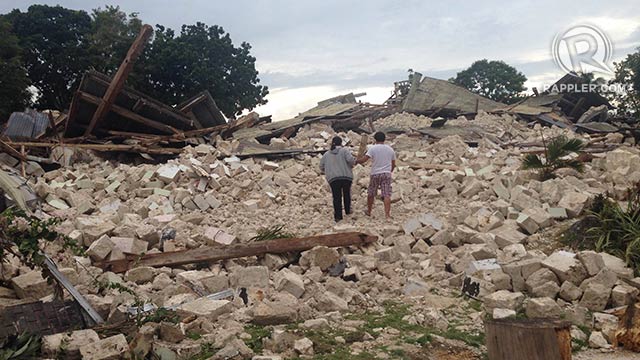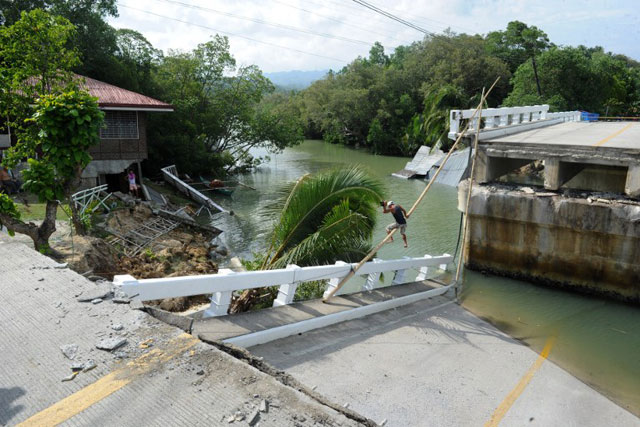SUMMARY
This is AI generated summarization, which may have errors. For context, always refer to the full article.

TAGBILARAN CITY, Philippines — Three days after the killer quake, Barangay Napo of Loon is a ghost town. Only the sound of chickens, goats, and the occasional helicopter flights fill the silence of residents who have lost their homes and live in constant fear of another earthquake.
They live in makeshift tents at the town plaza, beside mounds of rock, metal, and roofing —remnants of what used to be Loon’s pride, the Church of Our Lady of Light. At least 4 people remain buried in the church rubble, locals told Rappler.
One of them is a respected community leader, Mang Mike, who went to church daily. On Tuesday, October 15, when a 7.2 magnitude quake hit the town, the former elementary school teacher was praying the novena in one of the pews. He has yet to be found, along with other Loon locals.
His children and fellow teachers have been praying for him every day, lighting candles amid the rubble.
There might be more people or bodies trapped underneath the church, locals said. On Wednesday night, October 16, they kept hearing the voice of a young boy from the ruins: “Tabangi ko, tabangi ko.” (Help me, help me.)
The residents weren’t sure if it was a survivor or a ghost. Nobody was able to help.
Those who’ve lived in Loon for 30, 40, even 50 years, said it’s the worst thing they’ve seen in their lifetime.
Of the towns in Bohol, it was Loon that suffered the brunt. Mualong bridge, which connects Loon to nearby Calape town, remains impassable. The lack of bigger fishing vessels in the community makes it tough to seek help outside. Only boats and helicopters are able to reach the town. Severe injuries went untreated for more than a day after the quake.
Elementary school teacher Mirasol Lafuente barely had time to react when the powerful earthquake smashed Loon.
She only managed to grab her youngest child, drag her out of the house, and scream so her husband would run outside too.
“Ka-ingon na gyud ko’g mamatay ba kaha mi ani kay kaning balaya ambi mi’g mahansak na gyud tanan ba. Pirti, gilamba-lamba naman gyud mi… wala ko kasabot,” she said. (I thought I was going to die because I thought our house was going to crumble. We were swaying back and I forth.)
Mirasol and her family ran uphill to the town plaza. Other residents did the same, because they were afraid a tsunami would soon engulf the seaside barangay.
“Ang dagat mura nama’g nagbukal-bukal nahadlok nalang pud mi. Mao tong after adto, wala nako kabalo,” she added. (The sea was already turning restless. We got scared. After the quake, I didn’t know what to do.)
A gym close to the church is also in ruins. A construction worker who was scaling the gym during the quake was among the first who died.

Aftershocks
The slightest tremor makes the locals nervous. On Thursday morning, October 17, a magnitude 5.5 quake hit the Visayas region again. Although weak compared to the October 15 earthquake, families in Loon thought it would be another strong quake.
Aftershocks caused more damage after the quake, residents said. Houses and buildings have already collapsed and would not be able stand another disaster.
Many children are sick; they’re either coughing or nursing a fever. The occasional rain leaves them cold and wet at night. They have minimal access to potable water.
Help finally began to reach them on Thursday, when government and private groups began their second trip to the isolated town, bringing with them sacks of rice, food packets and medical kits. At least 33 Loon locals needed to be transferred to nearby cities with functioning hospitals. (READ: List of relief centers and contact details)
The day before, a handful were brought to Tagbilaran city, an hour away via pump boat.
Lafuente, who was born and raised in Loon, said her family would rather leave town for a while. But she can’t go just yet — she worries about her students who were so eager to get back to school.
They have relatives in Manila. But Lafuente thinks it’s still better for her children to stay in Loon, despite the trauma of the quake.
“Ibutang nato na delubyo siguro ning nahitabo namo karon nga dili ko ka-express… na unsa ka… worst ba kaha ni… ambot,” she said. (This is the worst thing I’ve experienced in my life. I can’t imagine why this would happen. The weather was fine, I don’t know. Until now, I don’t know.)
Her neighbors share the same fear of the future. But even if they want to leave Loon, where would they go?
– Rappler.com
Add a comment
How does this make you feel?
There are no comments yet. Add your comment to start the conversation.